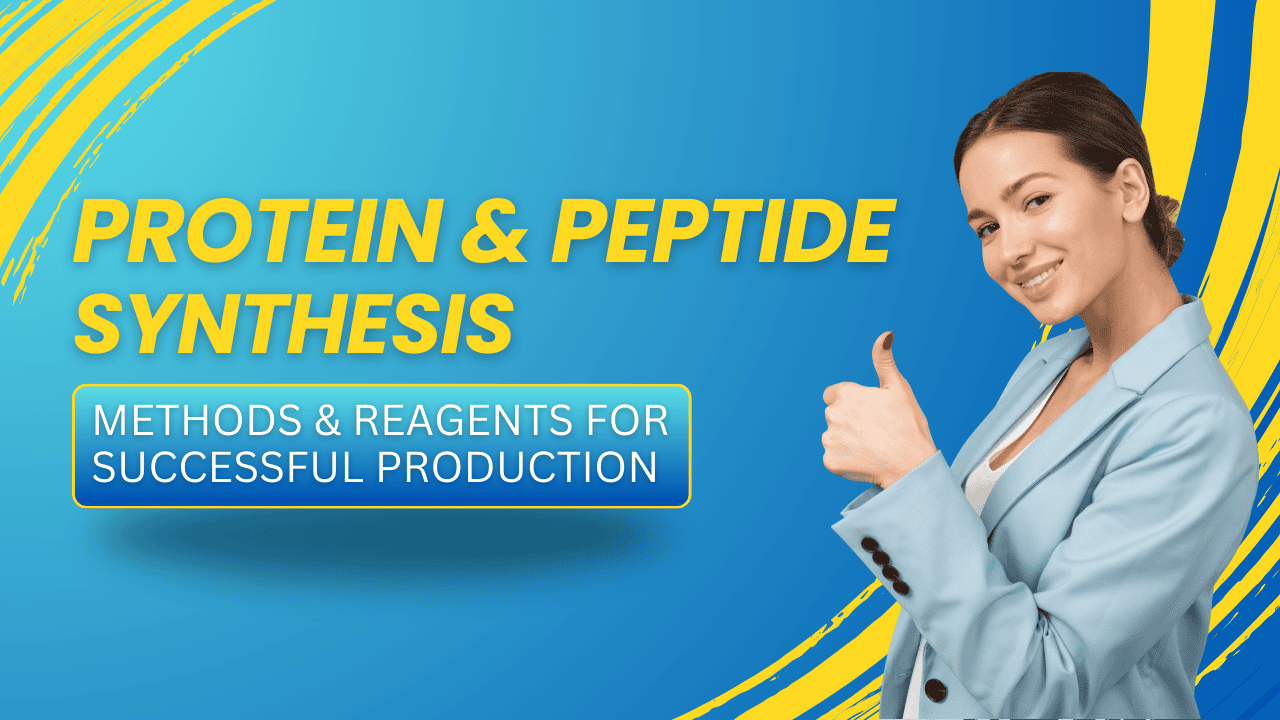

Peptides are fascinating little molecules that play a crucial role in countless biological processes, from triggering immune responses to transporting nutrients.
Delving into the intricacies of peptide design and modification is not just a thrilling scientific journey but also a necessity for advancing fields like medicine and biotechnology.
This article will walk you through advanced strategies for designing and modifying peptides, backed by intriguing anecdotes, insightful questions, and practical advice – making it a must-read for any peptide enthusiast.
Alright, let’s start with the basics. A peptide is a short chain of amino acids linked by peptide bonds. If you’ve ever thought of them as the younger cousins of proteins, you’re not far off. They form the building blocks of proteins but are often simpler and easier to study.
Peptides form through a process called peptide synthesis. Essentially, amino acids are linked in a specific sequence, creating a chain. It’s like putting beads on a string, only these beads are composed of essential biomolecules.
From acting as hormones to antimicrobial agents, peptides are significant in both health and disease. Their versatility makes them crucial in various applications, from developing new drugs to conducting research on protein structure and function.
Peptide design involves crafting specific sequences to achieve desired functions. Picture it as customizing features of a gadget to match the purpose it needs to serve – you get a tailored tool perfect for the task.
One must consider factors like amino acid composition, length, and the chemical environment. Such nuances ensure that the peptide performs its designated task efficiently.
Optimization often involves tinkering with the peptide sequence and trying various modifications until hitting the sweet spot in performance. It’s part science, part art.
The struggles are real, my friend—instability, hydrophobic interactions, and solubility issues can throw wrenches into the process. These need meticulous adjustments and innovative thinking to overcome.
Peptide modification is like giving your car a turbo engine or a slick new paint job. It involves altering the peptide to enhance its properties or functionality.
Modifications to peptides can improve their stability, solubility, and biological activity. Essentially, a peptide may be more effective when fine-tuned.
Common modifications include the addition of conjugates, methylation, or even introducing unnatural amino acids. The sky’s the limit!
Selection depends on the desired effect. Do you want increased stability? Better solubility? Tailoring the modification to the end goal is crucial.
A peptide sequence is the unique order of amino acids in a peptide chain. It determines the peptide’s characteristics and function.
Determining a peptide sequence involves sequencing techniques like mass spectrometry, which break down the amino acid components and arrange them in order.
Sophisticated tools like software algorithms and analytic instruments aid in deciphering and optimizing peptide sequences. It’s like solving a complex puzzle, piece by piece.
Issues include handling post-translational modifications or dealing with insolubility. Sometimes, identifying and eliminating residues that cause unexpected results is necessary.
A modified peptide may exhibit enhanced stability, increased solubility, or altered biological activity compared to its unmodified counterpart.
From drugs to diagnostic tools, modified peptides have a range of applications. They can even mimic natural peptides more effectively, making them valuable research tools.
Creating a modified peptide involves selecting the appropriate modifications and properly integrating them into the peptide sequence. Think of it as putting together a jigsaw puzzle where every piece matters.
Using modified peptides can lead to more effective treatments and applications. The benefits of modifying peptides are numerous, from better immune response triggers to increased efficacy in biotechnological applications.
Ever heard of custom peptide synthesis services? It’s like hiring an expert to tailor-make a peptide for you, ensuring precision and efficiency.
Look for reliability, turn-around time, and costs. Companies like Thermo Fisher Scientific are often preferred for their comprehensive service and quality.
A good service will provide high peptide purity, accurate sequencing, and flexible modification options. It’s like getting tailor-made clothes—quality and fit matter.
Costs can vary based on the complexity of the sequence and modifications required. Don’t skimp on this—quality matters!
Amino acids are the building blocks of peptides. Each amino acid brings unique properties to the peptide chain, influencing its function and stability.
Specific amino acids dictate the peptide’s structure and reactivity. For instance, hydrophobic amino acids can influence the solubility of the peptide.
Incorporating amino acids like lysine can improve peptide solubility and function. It’s like adding special ingredients to a recipe.
Selecting the right amino acids can be challenging due to factors like reactivity and stability. Picking the wrong ones can disrupt the peptide’s purpose.
Peptide synthesis is the preparation of peptides through chemical or enzymatic methods. Imagine it as building blocks, where each brick (amino acid) is meticulously placed.
Solid phase peptide synthesis is commonly used, allowing for precise control over the sequence. This technique has revolutionized the way we create peptides.
Optimum peptide synthesis involves tweaking reaction conditions to ensure high yield and purity. It’s a game of patience and precision.
Problems like incomplete reactions and unwanted side products may arise. Paying close attention to the synthesis conditions helps minimize these issues.
The N-terminal is the end of a peptide where the amino group (NH2) is free. It’s one starting point of the peptide that can influence its overall function.
The N-terminal can affect how a peptide behaves and interacts with other molecules. It’s like the first impression—it sets the tone for what follows.
N-terminal modifications can improve stability and function, such as through acetylation or conjugation with other molecules.
Modifying the N-terminal can be tricky, affecting the formation of stable peptide structures. The right approach ensures the modifications to meet desired outcomes.
Effective peptide design strategy involves considering the peptide’s purpose, environmental conditions, and required modifications.
Incorporating secondary structures like alpha helices can enhance peptide stability and function. It’s all about giving the peptide a robust framework.
Computational tools help predict peptide behavior and optimize sequences, saving time and resources. It’s like having a crystal ball for peptide design.
Examining successful peptide design strategies can provide valuable insights and inspiration. Learning from real-world examples is always enlightening.
Advanced techniques include chemical modification and peptide cyclization, enhancing peptide stability and function.
Choosing techniques depends on the desired outcome, whether it’s enhancing solubility, stability, or biological activity.
Challenges include maintaining peptide purity and ensuring successful integration of modifications. It requires meticulous planning and execution.
Peptide solubility refers to how easily a peptide dissolves in a solution, crucial for its function and application.
Factors include the peptide sequence, amino acid composition, and environmental conditions.
Improving solubility may involve sequence optimization, incorporating hydrophilic amino acids, or chemical modifications.
Issues like aggregation can hamper peptide solubility, affecting its effectiveness. Careful design helps in addressing these problems.
The C-terminal is where the carboxyl group (COOH) is free at the peptide’s end, playing a key role in its function.
The C-terminal influences how a peptide interacts and functions, much like the closing act in a play.
Modifications can enhance peptide stability and functionality, including amidation or conjugation with functional groups.
Challenges include maintaining the integrity and function of the peptide after modification. It’s a delicate balancing act.
Steps include selecting the right amino acids, determining the sequence, and planning modifications. Each step builds towards a functional peptide.
Peptide libraries offer diverse sequence options to select high-performance peptides. It’s like choosing the best players for a team.
Advanced approaches involve computational tools and innovative modifications to create custom peptides with specific functions.
Various available modifications include site-specific, chemical, and post-translational modifications, each enhancing peptide function.
The choice depends on the peptide’s intended use and desired characteristics. Tailoring modifications enhances performance.
Modifications enhance peptide stability, solubility, and activity, making them more versatile and efficient.
Trends include automation, higher precision, and faster turn-around times, driven by advances in technology and methodology.
Evaluation criteria include reliability, peptide purity, customization options, and customer service.
Pitfalls include inconsistent quality and overlooked details in peptide sequencing. Choosing reputable services is key to avoiding these issues.
Analyzing successful cases demonstrates the impact of meticulous design and execution in peptide synthesis services.
Yes, Genscript can perform KLH or BSA conjugation on a peptide even if it lacks cysteine in its sequence. They can use synthetic routes that include adding a suitable linker or spacer for the conjugation process.
Yes, a biotin residue can be added at the C-terminus of a peptide. This is a common peptide modification that enhances the peptide’s functionality and detection.
Yes, a spacer can be added at the C-terminus to increase the space between the peptide and the biotin. This facilitates better accessibility and interaction with target molecules.
Yes, peptide cyclization through a disulphide bond is possible even if it contains three cysteines. Specialized techniques ensure the correct cysteines form the desired bridge, enhancing peptide stability.
Yes, labeling a peptide with FITC directly at the N-terminus is feasible. FITC (fluorescein isothiocyanate) labeling provides a fluorescent tag, enhancing detection and analysis.
Yes, creating two branches on one original peptide is achievable. This involves synthesizing branched peptides, usually via adding lysine residues as branching points.
Yes, branched peptides can be made by incorporating branching amino acids like lysine or through other synthesis techniques. Branched structures enhance functionality and stability.
Yes, peptides can be synthesized with aspartic phosphorylation modification. This post-translational modification mimics natural processes and enhances peptide activity.
Yes, peptides can be synthesized with glutamine (Q) at the N-terminus. It’s incorporated seamlessly during peptide synthesis, providing the desired peptide structure.
Yes, peptides can be synthesized entirely with D amino acids. These synthetic peptides often have enhanced stability and resistance to enzymatic degradation compared to their L-amino acid counterparts.
Dr. Richard DiMarchi is a globally recognized expert in the field of peptide research, particularly noted for his pioneering work in peptide therapeutics and hormone research. With over three decades of experience, Dr. DiMarchi has made groundbreaking contributions that have significantly advanced our understanding and clinical applications of peptides. He has been pivotal in the development of glucagon-like peptide-1 (GLP-1) analogs, which are crucial for the treatment of diabetes and obesity.
Dr. DiMarchi’s notable publications include:
Through his extensive work, Dr. DiMarchi has earned numerous awards, including the American Chemical Society’s Smissman Bristol-Myers Squibb Award. His relentless pursuit of research excellence underscores his authority and reliability in the field of peptide science.
Dr. Jean Martinez is an esteemed scientist with profound expertise in peptide synthesis and modification. His research focuses on the development of synthetic peptides for therapeutic and diagnostic purposes. Dr. Martinez has contributed significantly to the field through his innovative work on peptide cyclization and the design of stable, bioactive peptides. With a career spanning over 25 years, he is highly regarded for his contributions to peptide chemistry and pharmaceutical sciences.
Key publications by Dr. Martinez include:
Dr. Martinez’s work is characterized by his innovative approaches and meticulous research methods, which have earned him accolades such as the European Peptide Society’s Josef Rudinger Memorial Lecture Award. His profound expertise and consistent contributions establish him as a trusted and authoritative figure in peptide science.
Baxter, D., Ullman, C. G., & Mason, J. M. (2014). Library construction, selection and modification strategies to generate therapeutic peptide-based modulators of protein–protein interactions. Future Medicinal Chemistry, 6(18), 2073–2092. https://doi.org/10.4155/fmc.14.134
Cong, Y., Scesa, P. D., & Schmidt, E. W. (2022). AGEMTPT, a catalyst for Peptide N-Terminal Modification. ACS Synthetic Biology, 11(11), 3699–3705. https://doi.org/10.1021/acssynbio.2c00312
Galloway, J. M., Bray, H. E. V., Shoemark, D. K., Hodgson, L. R., Coombs, J., Mantell, J. M., Rose, R. S., Ross, J. F., Morris, C., Harniman, R. L., Wood, C. W., Arthur, C., Verkade, P., & Woolfson, D. N. (2021). De Novo Designed Peptide and Protein Hairpins Self‐Assemble into Sheets and Nanoparticles. Small, 17(10). https://doi.org/10.1002/smll.202100472
Gao, S., Wang, Y., & Ji, L. (2020). Rational design and chemical modification of TEAD coactivator peptides to target hippo signaling pathway against gastrointestinal cancers. Journal of Receptors and Signal Transduction, 41(4), 408–415. https://doi.org/10.1080/10799893.2020.1818093
Liu, Y., Lu, X., Chen, M., Wei, Z., Peng, G., Yang, J., Tang, C., & Yu, P. (2023). Advances in screening, synthesis, modification, and biomedical applications of peptides and peptide aptamers. BioFactors, 50(1), 33–57. https://doi.org/10.1002/biof.2001
Majkowska, A., Inostroza-Brito, K. E., Gonzalez, M., Redondo-Gómez, C., Rice, A., Rodriguez-Cabello, J. C., Del Rio Hernandez, A. E., & Mata, A. (2023). Peptide–Protein Coassemblies into Hierarchical and Bioactive Tubular Membranes. Biomacromolecules, 24(10), 4419–4429. https://doi.org/10.1021/acs.biomac.2c01095
Rai, J. (2018). Peptide and protein mimetics by retro and retroinverso analogs. Chemical Biology & Drug Design, 93(5), 724–736. https://doi.org/10.1111/cbdd.13472
Wang, G., Li, X., & Wang, Z. (2015). APD3: the antimicrobial peptide database as a tool for research and education. Nucleic Acids Research, 44(D1), D1087–D1093. https://doi.org/10.1093/nar/gkv1278
Werner, H. M., Cabalteja, C. C., & Horne, W. S. (2015). Peptide backbone composition and protease susceptibility: impact of modification type, position, and tandem substitution. ChemBioChem, 17(8), 712–718. https://doi.org/10.1002/cbic.201500312
Zhang, J., Zhang, J., Wang, Y., Zhang, X., Nie, T., & Liu, Y. (2022). Strategies to improve the activity and biocompatibility: modification of peptide antibiotics. Foodborne Pathogens and Disease, 19(6), 376–385. https://doi.org/10.1089/fpd.2021.0112
ALL ARTICLES AND PRODUCT INFORMATION PROVIDED ON THIS WEBSITE ARE FOR INFORMATIONAL AND EDUCATIONAL PURPOSES ONLY. The products offered on this website are intended solely for research and laboratory use. These products are not intended for human or animal consumption. They are not medicines or drugs and have not been evaluated or approved by the FDA to diagnose, treat, cure, or prevent any disease or medical condition. Any form of bodily introduction is strictly prohibited by law.




Discount Applied Successfully!
Your savings have been added to the cart.